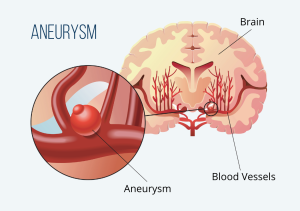A migraine and an aneurysm can both cause head pain, so it may be difficult to tell them apart. However, it is important to be able to tell the difference between the two because the treatment for each condition is different. Importantly, if you experience a sudden, severe headache that is unlike any headache you have ever had before, it is important to see a doctor right away.
In this post, we’ll first explain what migraines and aneurysms are. Then, we’ll discuss a few of their differences and how you may be able to distinguish the difference between the two.
 What is a migraine?
What is a migraine?
A migraine is a type of headache that can cause throbbing or pulsing pain. Typically, the pain occurs on one side of the head. It can be accompanied by other symptoms, such as nausea, light sensitivity, and vision changes. Migraine usually lasts from 4 to 72 hours and can be triggered by certain foods, stress, and hormonal changes.
Migraine is common. In fact, the JAMA Network reports that migraine affects more than an estimated 10% of people worldwide. It is three times more common in women than in men, though it can affect both genders. It is also more common in people with a family history of migraine and can start as early as childhood.
What is an aneurysm? 
An aneurysm is a bulge or ballooning in a blood vessel that results from a weakened area in the vessel wall. It can cause a sudden, extremely severe headache. Often, it is accompanied by a stiff neck, vomiting, confusion, and/or loss of consciousness. If the brain aneurysm ruptures or leaks, it causes the brain to bleed, which is known as a hemorrhagic stroke. An aneurysm can be life-threatening if left untreated and therefore, requires immediate medical attention.
Aneurysms are more common than you might think. In fact, the Brain Aneurysm Foundation estimates that approximately 6.7 million people in the United States have an unruptured brain aneurysm, or 1 in 50 people. Furthermore, women are more likely than men to have a brain aneurysm (3:2 ratio). Additionally, Brain aneurysms are most prevalent in people ages 35 to 60 but can occur in children as well. Most aneurysms develop after the age of 40.
How can I tell the difference between a migraine and an aneurysm?
There are several key factors to consider if you think you might have a migraine or an aneurysm. Understanding the symptoms of each that will help you distinguish between the two.
Migraine Symptoms
- A headache, typically located on one side of the head.
- Pain is described as throbbing, pounding, or pulsing that may worsen with physical activity.
- Often preceded or accompanied by visual disturbances, such as flashing lights, blind spots, and/or ‘zigzag’ lines
- Other symptoms may include nausea, vomiting, and sensitivity to light and sound.
- Pain typically lasts 4 to 72 hours.
Aneurysm Symptoms
- Sudden, very severe headache that comes on without warning.
- Pain can be located anywhere in the head.
- Often described as “the worst headache of my life”.
- May be accompanied by a feeling of pressure or a throbbing sensation.
- Pain is not relieved by medication.
- Other symptoms may include a stiff neck, nausea, vomiting, confusion, blurred or double vision, slurred speech, and loss of consciousness.
- Comes on suddenly and can last for several days.
When should I seek medical attention?
If you experience any of the symptoms of an aneurysm, it is important to seek medical attention immediately. A ruptured aneurysm is a medical emergency that requires immediate treatment. With prompt treatment, the chances of survival are good.
Additionally, if you notice any changes in your migraine symptoms, you should seek medical attention. Your doctor will be able to perform tests to determine the cause of your change in symptoms and provide treatment to prevent serious complications.
How can I reduce my risk of a brain aneurysm?
Interestingly, brain aneurysms form randomly and for reasons we do not fully understand. However, you can reduce your chances of having an aneurysm by controlling your blood pressure, quitting smoking, and living a healthy lifestyle.
If you have any concerns about your risk of developing a brain aneurysm, talk to your doctor.
 About Dr. Ulm
About Dr. Ulm
Arthur J. Ulm, MD, is a Board Certified Neurosurgeon specializing in spinal disorders, brain vascular disease, and brain and spine tumors. Dr. Ulm’s clinical interests include the treatment of cerebrovascular disease with traditional open surgery and endovascular techniques, as well as the treatment of complex spinal problems with minimally invasive surgery. He has practiced neurosurgery for over 12 years and is a founding member of Nashville Neurosurgery Associates. Dr. Ulm also founded the Centennial Medical Center Neurovascular Stroke Program. He has published numerous peer-reviewed articles and has over 40 patents for stroke treatment technology. Dr. Ulm offers expertise in treating the following conditions:
- Aneurysms
- Stroke
- Hemifacial spasm
- Brain tumors
- Neurovascular disease
- Vascular malformations
- Moyamoya
- Degenerative spine disease
Learn more about Dr. Ulm and his care team>
Disclaimer
This blog provides general information and discussions about health and related subjects. The information and other content provided in this blog, or in any linked materials, are not intended and should not be construed as medical advice, nor is the information a substitute for professional medical expertise or treatment.
If you or any other person has a medical concern, you should consult with your healthcare provider or seek other professional medical treatment. Never disregard professional medical advice or delay in seeking it because of something read on this blog or in any linked materials. If you think you may have a medical emergency, call your doctor or emergency services immediately.
The opinions and views expressed on this blog and website have no relation to those of any academic, hospital, health practice, or other institution.

